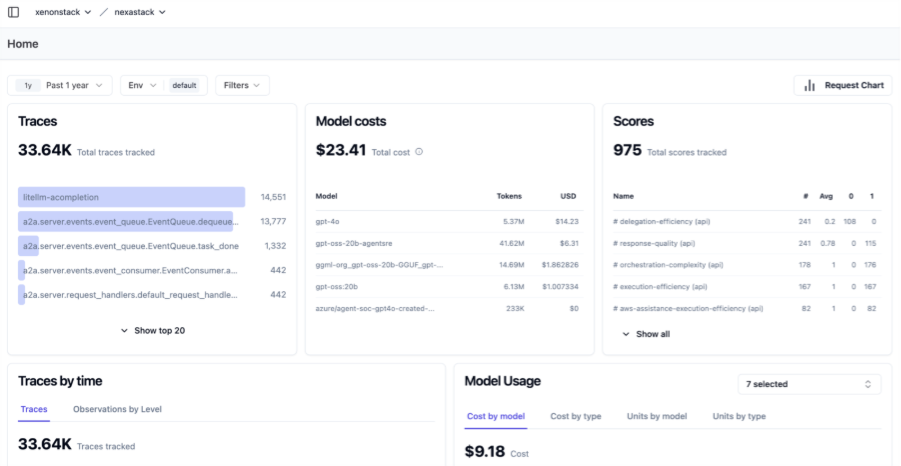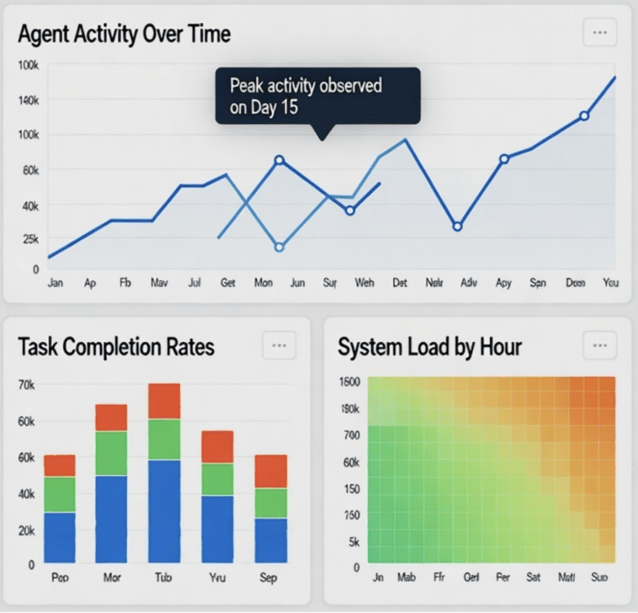Why Evaluation and Observability Must Work Together
Evaluation provides a picture of the agent's capabilities by putting them through controlled benchmarks, whereas observability offers real-time information on how the agent is running. Their combination is essential in resolving the disconnect between the agent's capabilities as lab-tested and the real difficulties of live deployment.
Static tests may confirm functionality in isolation, but with a lack of observability, they can overlook tests in variables such as variable load or integration problems, which can result in surprises in production, such as unexplained latency in handoffs between agents. For example, in cloud settings, observability programs such as Open Telemetry are used to standardize data collection, and evaluation can be made using live metrics, which provides a more precise view of reliability assessment.
It is particularly essential in the case of backend systems, where AI agents perform sensitive work, ensuring compliance and cost-effectiveness by matching evaluation scores with actual token consumption or error statistics. This hybrid method of regression testing is automated in DevOps pipelines to indicate drifts that may affect user experience in applications, such as incident management dashboards.
Core Evaluation Dimensions – Functionality, Reliability, and Explainability
AI agent evaluation functionality measures task completion across a wide range of conditions, using test platforms such as Agent Bench or our custom datasets, to assess how well agents behave in web navigation, coding, or data retrieval, without taking shortcuts to achieve their intended goals.
Tools, such as Galileo, offer additional metrics beyond accuracy, including response variance or hallucination detection, to identify drifts during long-running sessions. For backend engineers, this implies that load balancing agents in simulated loads should be stress-tested to ensure uptime in systems handling real-time logs or transactions.
Agent Observability Metrics – Latency, Responsiveness, Context Retention
Models provide decision tree visualization, allowing for the inspection of context retention in multi-turn interactions. In contrast, semantic descriptions of outputs can be generated by LLM-as-a-judge (LaaJ) methods. This is a crucial dimension for multi-agent systems, where explainability reveals misunderstandings between agents to inform optimizations in observability dashboards.
OpenTelemetry is used by modern platforms to standardize such measurements, allowing for cross-tool comparisons in a hybrid environment. Their accumulation indicates overall system flaws, e.g., latency and the correlation between context loss, which signal an ineffective prompting strategy. They have also caused automation in production, such as auto-scaling resources based on responsiveness trends, which enhances the overall performance of the agent.

Tools and Frameworks for Evaluating AI Agents
OpenDeepeval is one of these open-source frameworks, similar to Pytext, that provide modular semantic correctness, hallucination, and agent-specific evaluation metrics, which are well-suited for CI/CD integration in Python pipelines. It facilitates custom datasets and LaaJ to automate grading, making it suitable for testing the reliability of multi-agent backends without the need for heavy infrastructure. It can be extended by the developers to fit domain-specific requirements, including testing the routing of payments in fintech agents.
Confident AI builds DeepEval as a cloud service to offer scalable benchmarking, security vulnerability red-teaming, and annotation tools, as well as features such as A/B testing, enabling immediate iterations. Additionally, it integrates models provided by OpenAI with Gemini. For more advanced users, it also supports multi-modal evaluations, which include voice or image input in addition to text.
Langfuse focuses on tracing LangGraph and other frameworks, as well as tracing spans in LLM calls, tool execution, and user sessions. Exportable data can be used in custom analyses in Grafana or PostgreSQL configurations. It does well in context propagation, retention, and explainability logging scores, and facilitates feedback loops in multi-agent orchestration. Galileo adds agent-oriented metrics, such as a score of reliability of non-determinism and drift detection, and provides templates of planning and reflection phases of agent lifecycles.

Integrating Observability and Evaluation Dashboards
The incorporation of dashboards brings together diverse data into integrated perspectives, as seen in the case of Azure AI Foundry, where evaluation scores are superimposed over runtime traces to create holistic agent control, as measured by metrics such as cost and quality. This involves instrumenting code with SDKs from such tools as Langfuse or Galileo, tracing into centralized platforms to query using an SQL-like interface or visual filters.
This configuration in Kubernetes-managed systems aligns the performance of the agents with the infrastructure metrics, enabling the distribution of resources to latency-sensitive tasks.

Building Feedback Loops – From Metrics to Meaningful Insights
In routing across multiple models, such as LiteLLM, loops dynamically adjust the traffic to trusted models based on their responsiveness history. The agents that are highly self-improving incorporate reflection mechanisms that examine previous sessions through the LaaJ to modify the behaviours independently, as in the case of stateful workflows of LangGraph. This circular cycle, as described in the guide by Sendbird, involves a series of steps that include defining goals, curating data, analyzing it, and refining it so that agents can respond to changing business requirements, such as SLOs in observability systems.
In the case of SRE, loops are used in conjunction with incident management, where metrics are utilized to automatically generate reports that guide post-mortems and minimize the manual effort required to process massive volumes of logs. The five-step model at Oracle focuses on the cyclical nature of iteration, and evals are considered continuous to deal with adversarial situations or scale variations. The production risks are reduced through the production processes, as these loops produce adaptive intelligence by deriving meaning, as seen in cases of high token use and poor explainability.
Conclusion – Continuous Learning and Self-Improving Agents
The maturity of AI agent observability tools and assessment frameworks marks the beginning of an era of autonomous and robust systems that utilize metrics to continually improve and bring efficiency and innovation to AI development environments. A combination of these efforts, whether through the modular testing of OpenDeepeval or the tracing, as implemented by Langfuse, will enable the engineer to develop an agent that not only works but also grows and improves with wise feedback, the key to maintaining backends and SREs in changing conditions.
Frequently Asked Questions (FAQs)
Explore how observability and evaluation tools ensure reliable, transparent, and governable AI agent behavior across enterprise environments.
Why do AI agents need dedicated observability tools?
Agents make multi-step decisions, requiring visibility into reasoning traces, tool calls, and state transitions to ensure trust and safety.
What metrics matter most for evaluating agent performance?
Key metrics include task success rate, cost per action, latency, drift signals, and policy compliance scores.
How do evaluation tools prevent silent agent failures?
Automated regression tests, scenario simulations, and anomaly detection pipelines flag unexpected behavior before it reaches production.
How do observability tools support multi-agent systems?
They capture inter-agent communications, dependency graphs, and orchestration timelines to diagnose coordination issues.
Can observability run in private or air-gapped environments?
Yes—Nexastack supports fully local logging, secured audit trails, and offline evaluation workflows without external telemetry.
.webp?width=1921&height=622&name=usecase-banner%20(1).webp)





